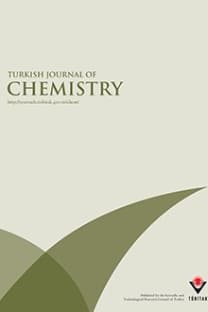Optimization of the adsorption of a textile dye onto nanoclay using a central composite design
Adsorption, central composite design, experimental design, montmorillonite K10, nanoclay
Optimization of the adsorption of a textile dye onto nanoclay using a central composite design
___
- Noorimotlagh, Z.; Darvishi Cheshmeh Soltani, R.; Khataee, A. R.; Shahriyar, S.; Nourmoradi, H. J. Taiwan Inst.
- Chem. Eng. 2014, 45, 1783–1791.
- Khataee, A. R.; Fathinia, M.; Aber, S.; Zarei, M. J. Hazard. Mater. 2010, 181, 886–897.
- G¨urses, A.; Do˘gar, C¸ .; Yal¸cın, M.; A¸cıkyıldız, M.; Bayrak, R.; Karaca, S. J. Hazard. Mater. 2006, 131, 217–228.
- Darvishi Cheshmeh Soltani, R.; Khataee, A. R.; Safari, M.; Joo, S. W. Int. Biodeter. Biodegr. 2013, 85, 383–391.
- Darvishi Cheshmeh Soltani, R.; Rezaee, A.; Shams Khorramabadi, G.; Yaghmaeian, K. Water Sci. Technol. 2011, 63, 129–135.
- Shams Khorramabadi, G.; Darvishi Cheshmeh Soltani, R.; Rezaee, A.; Khataee, A. R.; Jonidi Jafari, A. Can. J.
- Chem. Eng. 2012, 90, 1539–1546.
- Uzun, ˙I.; G¨uzel, F. Turk. J. Chem. 2000, 24, 291–298.
- Qadeer, R.; Rehan, A. H. Turk. J. Chem. 2002, 26, 357–362.
- G¨urses, A.; Do˘gar, C¸ .; Karaca, S.; A¸cikyildiz, M.; Bayrak, R. J. Hazard. Mater. 2006, 131, 254–259. 10.Darvishi Cheshmeh Soltani, R.; Khataee, A. R.; Godini, H.; Safari, M.; Ghanadzadeh, M. J.; Rajaei, M. S. Desalin.
- Water Treat. 2014, 1–14. 11.G¨urses, A.; Karaca, S.; A¸cikyildiz, M.; Ejder, M. Chem. Eng. J. 2009, 147, 194–201.
- Teng, M.-Y.; Lin, S.-H. Desalination 2006, 201, 71–81.
- Wibulswas, R. Sep. Purif. Technol. 2004, 39, 3–12.
- Wang, L.; Wang, A. J. Hazard. Mater. 2008, 160, 173–180. 15.Selvam, P. P.; Preethi, S.; Basakaralingam, P.; Thinakaran, N.; Sivasamy, A.; Sivanesan, S. J. Hazard. Mater. 2008, 155, 39–44.
- Wang, C.-C.; Juang, L.-C.; Hsu, T.-C.; Lee, C.-K.; Lee, J.-F.; Huang, F.-C. J. Colloid Interface Sci. 2004, 273, 80–86.
- Hassani, A.; Darvishi Cheshmeh Soltani, R.; Karaca, S.; Khataee, A. J. Ind. Eng. Chem. 2015, 21, 1197–1207.
- W.; Unger, K. K. Stud. Surf. Sci. Catal. 1994, 87, 1–9. 23.Sing, K. S. W.; Everett, D. H.; Haul, R. A. W.; Moscou, L.; Pierotti, R. A.; Rouquerol, J.; Siemieniewska, T. Pure
- Appl. Chem. 1985, 57, 603–619. 24.Sing, K. S. W.; Everett, D. H.; Haul, R. A. W.; Moscou, L.; Pierotti, R. A.; Rouquerol, J.; Siemieniewska, T. In
- Handbook of Heterogeneous Catalysis, Vol. 2 ; 2nd ed.; Ertl, G., Kn¨ozinger, H., Sch¨uth, F., Weitkamp, J., Eds.
- Wu, Z.; Joo, H.; Ahn, I.-S.; Haam, S.; Kim, J.-H.; Lee, K. Chem. Eng. J. 2004, 102, 277–282. 33.Al-Ghouti, M. A.; Al-Degs, Y. S. Chem. Eng. J. 2011, 173, 115–128. ¨
- Ozt¨urk, A.; Malkoc, E. Appl. Surf. Sci. 2014, 299, 105–115.
- Khataee, A. R.; Zarei, M.; Moradkhannejhad, L. Desalination 2010, 258, 112–119.
- Haber, A.; Runyun, R. General Statistics; 3rd edn. Boston, MA, USA: Addison-Wesley, 1977.
- Khataee, A. R.; Zarei, M.; Asl, S. K. J. Electroanal. Chem. 2010, 648, 143–150. 38.Darvishi Cheshmeh Soltani, R.; Rezaee, A.; Godini, H.; Khataee, A. R.; Hasanbeiki, A. Chem. Ecol. 2012, 29, 72–85. 39.Khataee, A. R.; Kasiri, M. B.; Alidokht, L. Environ. Technol. 2011, 32, 1669–1684.
- Deniz, F.; Saygideger, S. D. Desalination 2010, 262, 161–165.
- Zhou, C.-H.; Zhang, D.; Tong, D.-S.; Wu, L.-M.; Yu, W.-H.; Ismadji, S. Chem. Eng. J. 2012, 209, 223–234.
- Ghorbani, F.; Younesi, H.; Ghasempouri, S. M.; Zinatizadeh, A. A.; Amini, M.; Daneshi, A. Chem. Eng. J. 2008, 145, 267–275. 43.Silva, M. M. F.; Oliveira, M. M.; Avelino, M. C.; Fonseca, M. G.; Almeida, R. K. S.; Silva Filho, E. C. Chem. Eng.
- J. 2012, 203, 259–268.
- Salleh, M. A. M.; Mahmoud, D. K.; Karim, W. A. W. A.; Idris, A. Desalination 2011, 280, 1–13.
- Hu, B.; Luo, H. Appl. Surf. Sci. 2010, 257, 769–775.
- Sheshdeh, R. K.; Nikou, M. R. K.; Badii, K.; Limaee, N. Y.; Golkarnarenji, G. J. Taiwan Inst. Chem. Eng. 2014, 45, 1792–1802. 47.Karaca, S.; G¨urses, A.; Ejder, M.; A¸cıkyıldız, M. J. Colloid Interface Sci. 2004, 277, 257–263.
- de Luna, M. D. G.; Flores, E. D.; Genuino, D. A. D.; Futalan, C. M.; Wan, M.-W. J. Taiwan Inst. Chem. Eng. 2013, 44, 646–653.
- Madeira, M.; Auxtero, E.; Sousa, E. Geoderma 2003, 117, 225–241.
- Khataee, A. R.; Dehghan, G. J. Taiwan Inst. Chem. Eng. 2011, 42, 26–33.
- ISSN: 1300-0527
- Yayın Aralığı: 6
- Yayıncı: TÜBİTAK
Mehmet Serdar GÜLTEKİN, Haydar GÖKSU
Microwave-assisted synthesis of novel 8-chloro-[1,2,4]triazolo[4,3-$a$]pyridine derivatives
LINJIONG ZHANG, MINGYAN YANG, Beizhen HU, ZHAOHUI SUN, XINGHAI LIU, JIANQUAN WENG, CHENGXIA TAN
Yaşar DÜRÜST, Eda SAĞIRLI, Akin SAĞIRLI
ERDEM KAMİL ÖZER, MİYASE GÖZDE GÜNDÜZ, AHMED EL-KHOULY, MEHMET YILDIRIM SARA, RAHİME ŞİMŞEK, ALPER BEKTAŞ İSKİT, OSMAN CİHAT ŞAFAK
BURAK ZAFER BÜYÜKBEKAR, FARUK ÖZEL, HÜSEYİN ŞAKALAK, HALİT ÇAVUŞOĞLU, MUSTAFA ERSÖZ, MAHMUT KUŞ, MUSTAFA SELMAN YAVUZ
Functional gold nanoparticle coated surfaces for CA 125 cancer biomarker detection
İlknur TUNÇ, Hepi Hari SUSAPTO, Mustafa Özgür GÜLER
Gonca TOSUN, Tayfun ARSLAN, Zeynep İSKEFİYELİ, Murat KÜÇÜK, Şengül Alpay KARAOĞLU, Nurettin YAYLI
Enhanced electrocatalytic efficiency of C/MWNTs for methanol oxidation using Ni deposited on MWNTs
Priyanka A. SHAH, Primal SHARMA, Jaivik V. SHAH, Mallika SANYAL, Pranav S. SHRIVASTAV
